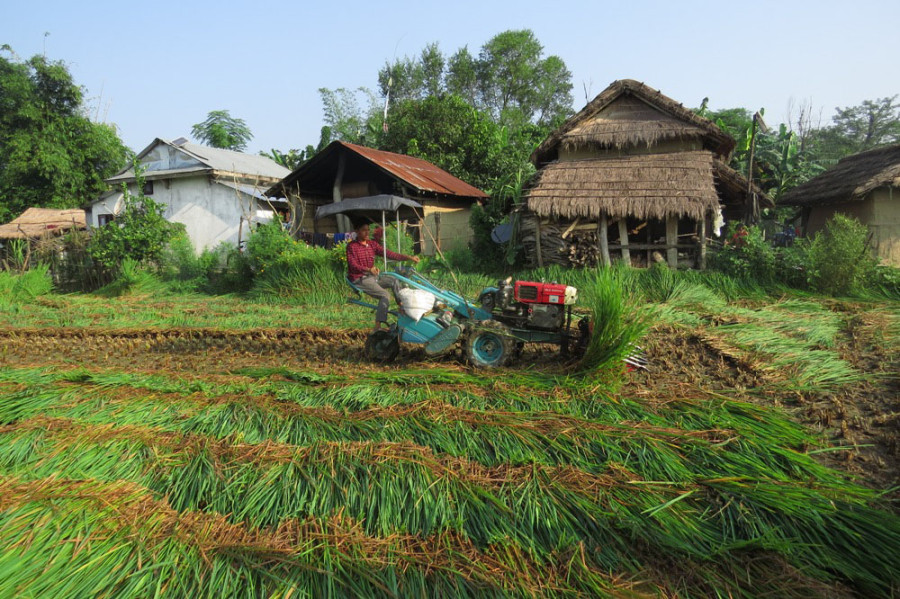Money
Officials say paddy output may shrink and stall economic growth
Farmers were hit by a delayed monsoon, fertiliser shortage, supply of fake seeds and armyworm invasion.
Sangam Prasain
The drop in output may affect the country’s ambitious 8.5 percent economic growth target for this fiscal year and also increase rice imports, economists said. Farmers have already started bringing in their paddy crops.
The harvest hit a record high of 5.61 million tonnes in the last season, up 9 percent year-on-year, thanks to a good monsoon and sufficient supply of chemical fertiliser.
“We think production may drop 7-8 percent this year,” said Yubak Dhoj GC, secretary at the Ministry of Agriculture and Livestock Development.
The monsoon started late and dumped 'below normal' rains, and farmers couldn't get adequate fertiliser due to delayed imports. The monsoon accounts for 75 percent of the annual rainfall. The paddy growing season lasts for four months from May to August, and the harvest continues until October.
The Agriculture Ministry had planned to purchase 286,000 tonnes of chemical fertiliser this fiscal year, but due to the appreciation of the dollar and a price rise in the global market, it was able to buy only 227,000 tonnes.
The Finance Ministry delayed releasing a payment of Rs3 billion to the Agriculture Ministry to import additional fertiliser to make up for reduced purchases due to a stronger US dollar and a price hike in the global market.
“We were not able to distribute enough amounts of subsidised fertiliser,” said GC. “The annual requirement of chemical fertiliser is 700,000 tonnes. Besides, the fertiliser distribution mechanism is not effective.”
According to GC, a hybrid variety of paddy named Garima produced only empty grains in many places. The ministry’s investigation showed that the dealer had sold fake Garima brand paddy seeds to farmers during the planting season. A preliminary investigation found that Garima planted on 1,404 hectares produced empty grains.
The most affected districts were Chitwan, Kailali, Banke and Bardia. According to the government report, the supplier had imported 34 tonnes of Garima seeds and sold 23 tonnes, including 13 tonnes in Chitwan.
An armyworm invasion wiped out paddy crops on 17,000 hectares in different parts of the country, according to the Agriculture Ministry. GC said the actual scale of damage caused by the armyworm invasion is yet to be known.
The invasion of armyworm has been growing rapidly in Nepal, said agro economist Krishna Prasad Pant. “If this pest is not controlled in time, it may be difficult to stop its spread in the coming years.”
Pant said that the armyworm arrived in Nepal from a harsh environment. “As Nepal’s climate is favorable for them, they can breed prolifically.”
He said that the Garima seeds and armyworm invasion would not impact national production much, but a large number of households whose livelihoods depend on their paddy harvest could be hit hard. “But overall, from a delayed monsoon to pest infestation, the country may witness a sharp fall in paddy production,” he said, adding that Nepal’s economy which is dependent on the farm sector may suffer the effect too.
The country has witnessed a normal monsoon for three consecutive years, propelling the country to record growth rates of over 6 percent for three years in a row.
Economist Chandan Sapkota said multiple problems seen in the farm sector this year would lower agricultural output growth. “It means the government will not be able to achieve its ambitious growth target of 8.5 percent.”
Sapkota said that farmers would also experience income stress since the government hasn't initiated any scheme to cushion the effect of an income setback.
“The monsoon is exogenous and sometimes it's bad and at other times it's good. But pesticide resistant worms and intrusion by new variants of worms are serious issues. The government hasn't been proactive in resolving this serious issue.”
The performance of Nepal’s economy is dependent on the farm sector. In the fiscal year 2016-17, the country’s gross domestic product expanded by 7.74 percent, the highest since fiscal 1993-94, largely due to an above-normal monsoon that helped Nepal to secure the biggest paddy harvest of 5.23 million tonnes, in a rebound from two consecutive years of falling harvests triggered by drought.
The economy grew by 6.3 percent in the following year 2017-18, according to the Central Bureau of Statistics. In 2017-18, Nepal’s paddy output totalled 5.15 million tonnes, down 1.49 percent from the 2016-17 bumper harvest, mostly on account of the August floods in the southern Tarai plains, known as the country’s food basket.
But the harvest was the second biggest despite the damage caused by the floods. In the last fiscal year, the country’s economy grew by 7 percent driven by the agriculture sector.




 5.3200000000001°C Kathmandu
5.3200000000001°C Kathmandu















